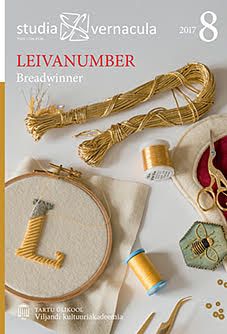Kuldtikand Eestis 20. sajandil: Tallinna Kaarli kiriku altarikattefragmendi näitel / Goldwork in Estonia in the 20th century as exemplified by a fragment of the altar cloth at the Kaarli Church in Tallinn
DOI:
https://doi.org/10.12697/sv.2017.8.109-121Abstract
The aim of this article is to introduce the Estonian goldwork tradition. In folk art, goldwork, or metalwork embroidery, has also been referred to as ‘tinsel embroidery’. It is a form of embroidery which uses different types of metal threads (containing gold, silver, copper, and other metals) and spirals, which are attached to the fabric using a fine thread. In the Estonian context, goldwork is a somewhat rarefied and narrowly-spread handicraft technique.
In Estonia, goldwork played an important role in the decoration of church and military textiles. At the request of the Lutheran Church, goldwork was taught at the Department of Textile Design of the State School of Arts and Crafts between 1935 and 1940. In 1937, Aino Schmidt, an alumna of that institution, created several custom-made altar cloths, embellished with goldwork for the Kaarli Church in Tallinn. Rather than being made from velvet, as was typical at the time, the altar frontal and two lectern covers were made from white baize and embroidered with metal studs as well as with golden threads, spirals, and beads. Since the zeitgeist encouraged the young nation state to emphasise its uniqueness, it is understandable that ecclesiastical symbols were presented with simple traditional ornamentation and stylisation. After World War II, Estonia’s territory was incorporated into the Soviet Union, and churches came to be looked on with great disdain, thus the creation of church textiles and goldwork came to a halt. The creation of new textiles for churches resumed once more when Estonia regained its independence. Unfortunately, goldwork is no longer used in the creation of the textiles for the Estonian Lutheran Church and tapestry-weaving techniques are preferred instead.
Nowadays there is no educational institution in Estonia where it would be possible to study the art of goldwork. Nor is there any master in Estonia who focuses on goldwork, nor anybody shaped by the local tradition from the beginning of the past century who would be able to teach the art of goldwork. And no instructions survive as to how goldwork was taught at the State School of Arts and Crafts. Since the teachers and the local master had a background in earlier traditions, it might be assumed that these instructions were mainly influenced by the Vienna and St. Petersburg schools.
This article therefore mainly draws deliberately on the textiles that Schmidt created for the Kaarli Church in Tallinn; albeit the textiles have been ravaged by time. In addition, it is possible to draw on the knowledge and skills I have acquired while working under the guidance of Tatjana Kolosova (a representative of the English goldwork tradition) in Riga and the nuns at the Mount of Olives Convent of the Ascension of Our Lord in Jerusalem (representatives of the Moscow goldwork tradition). I singled out a pattern fragment where each technique used on the entire altar cloth was present. I paid close attention to the technology of the original artefact during the process of reconstruction. Although I did rely on modern possibilities in a few of the preparatory stages, traditional and time-consuming techniques were used while working on the reconstruction. Although my aim was to study the proper technique during the process of reconstruction and not to imitate the original, I did try to use as much as possible materials that were similar to the original.
My so-called hands-on approach allowed me to conduct a more diverse study on old technical solutions, offering an opportunity to learn from the old masters without meeting them in person. The artefacts I examined, and which acted for me as the main means of communication with the past masters, were placed in a larger cultural framework and an overview concerning what is known about these masters has also been included in my study. The present study and reconstruction is an important step towards rediscovering goldwork techniques.
Keywords: goldwork, goldwork embroiderer, altar cloth, church vestments, reconstruction

